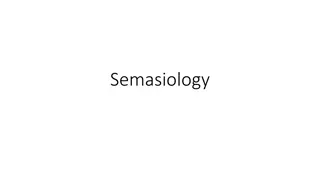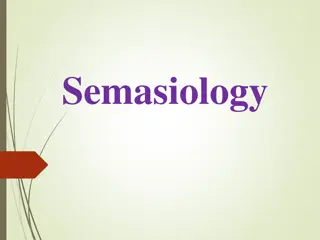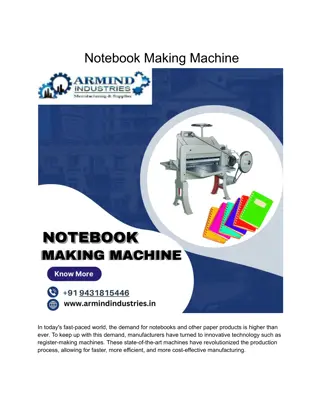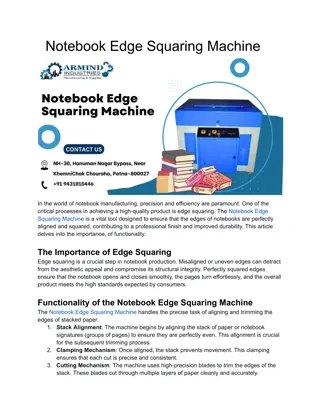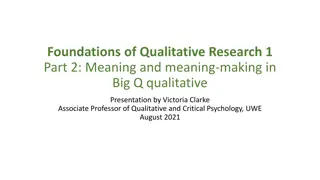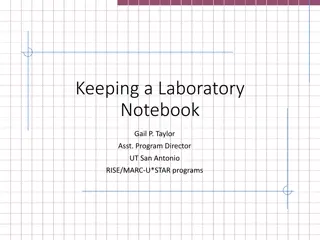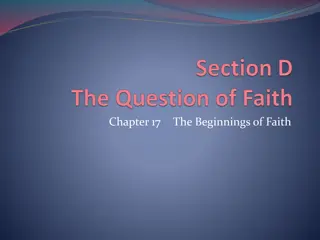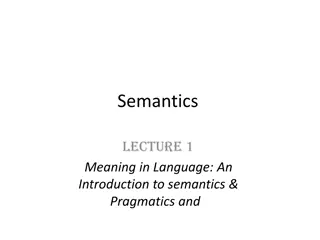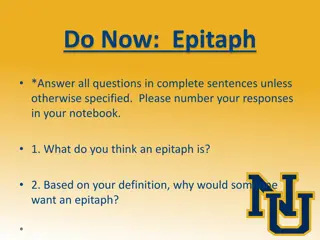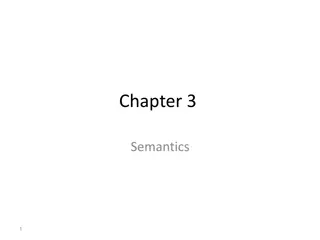Reflecting on The Notebook: Exploring the Meaning of Life
In this project, experts from Roma Tre University in Italy delve into the essence of life through The Notebook. The F.A.R.O. Project aims to make networks and provide guidance to immigrants, shaping their aspirations and interests. Module 2 focuses on personal history and migration experiences, offering a platform for self-expression. The Notebook structure includes pages on the imagined future, finding meaning, analyzing values, the role of values, developing the art of living, and sharing insights.
Download Presentation

Please find below an Image/Link to download the presentation.
The content on the website is provided AS IS for your information and personal use only. It may not be sold, licensed, or shared on other websites without obtaining consent from the author.If you encounter any issues during the download, it is possible that the publisher has removed the file from their server.
You are allowed to download the files provided on this website for personal or commercial use, subject to the condition that they are used lawfully. All files are the property of their respective owners.
The content on the website is provided AS IS for your information and personal use only. It may not be sold, licensed, or shared on other websites without obtaining consent from the author.
E N D
Presentation Transcript
The Notebook to The Notebook to reflect the the Meaning Meaning of Life reflect on of Life on Concetta La Rocca, Massimo Margottini Roma Tre University Italy concetta.larocca@uniroma3.it; massimo.margottini@uniroma3.it Innovations in Learning and Technology for the Workplace and Higher Education. The Learning Ideas Conference 2022 June 15-17, 2022, in New York and online
The F.A.R.O. PROJECT The F.A.R.O. PROJECT In In Italian ItalianFARO FARO means means slighthouse slighthouse The F.A.R.O. Project (acronym: FAre Reti e Orientare - Make networks and Guidance) was co-financed by the EU and the Italian Ministry of the Interior (Ministry of Domestic Affairs). The FARO project (08/07/2019 - 31/03/2022) was coordinated by Massimo Margottini (Department of Education at Roma Tre University, Italy) and follows the path traced by the previous CREI Project (CREI: CreareREti per gli Immigrati - Creating Networks for Immigrants) (10/01/2017 - 31.03.2018)
F.A.R.O. Project Plan ( F.A.R.O. Project Plan (synthetic synthetic) ) Aim The Project, which ended on 31/03/2022, had the objective of experimenting the construction of an integrated network aimed at responding to the training and work needs of citizens of Third Countries in some Italian territories. Methodology The project involved the use of multiple methodologies and tools, developed by Roma Tre research group, and submitted in training modules to the operators of local agencies for the instruction and training of young migrants. There were seven modules, all characterized by two closely related aspects: a theoretical section for study and reflection, and a laboratory section, for the practical use of methodologies and tools and also for reflection In each module participants are asked to use a personal computer to fill in the provided tools.
Module 2 Module 2 - - Personal history: narration about oneself, personal Personal history: narration about oneself, personal experience, and migratory project experience, and migratory project The Notebook to Reflect on the Meaning of Life is the tool presented in Module 2 Notebook theoretical framework : the measures to guide young immigrants cannot be reduced to the exclusive goal of identifying their professional skills to facilitate integration into the labor market; rather, they should aim to bring out desires and projects, expectations, and interests.
The structure of the Notebook The Notebook consists of the following 6 pages: 1 - The imagined future 2. Finding the meaning 3. The Analysis of the values 4. The role of values in one's life 5. Developing the art of living 6. The sharing For each page of the Notebook, the exercises are briefly described below; also, the quantitative results of the administration are reported
The Notebook application context As part of the FARO project, the Notebook was tested in CPIA2 and CPIA3 (CPIA: Provincial Center for Adult Education) in Rome. Each Notebook was compiled on a word file and assembled using a Google drive presentation.
The Notebook application context CPIA 2 CPIA 3 Period April / June 2021 May / June 2021 September / October 2021 - - Teachers who used the QSV eight - two - Classes in which QSA was administered across all classes literacy courses first period of the first level (middle school ) - - - Students to whom it has been proposed to all students students with a level of Italian between basic and intermediate - -
Home Country India Madagascar Per Sri Lanka Afghanistan Camerun Costa d'Avorio Guinea Argentina Italy Democratic Republic of Congo Egypt Kenya Bangladesh Senegal USA Pakistan Gambia Nigeria Morocco Somalia Iran Ukraine Tunisia Colombia Per Iraq 3 3 2 4 3 1 2 1 1 1 2 1 2 4 1 1 6 1 1 2 2 1 1 1 1 1 2 Respondents = 50 CPIA3 =18 CPIA 2 = 32 Male = 19 Female = 31
Total Training Years Knowledge of the Italian Language up to 7 years (elementary level) 1 Elementary 5 Pre-intermediate 20 Intermediate Advanced 12 Mastery 8-10 years (medium level) 11 11-16 years (upper level) 37 13 over 16 (university level) 1 0
1 - The imagined future Methodology: the operator uses tools and materials of various kinds to allow the subject to build his image of the future to show himself, to the operator and to whoever else he wants; the operator emphasizes that the work is not finished and that the subject can add any other elements over time. The inserted image is: a collage a handmade representation photo (drawing, painting, etc.) 2 an image downloaded from the internet a photo taken by the author of the Notebook there is no image 4 18 29 1
2. Finding the meaning Methodology: the operator leads the subject in the execution of two exercises: 1. the praise of a character or a person considered exemplary; 2. the description of an artistic work of various kinds (painting, film, image, video or piece of music etc.) and on the reflections arising from its use. The artistic work is chosen by the operator and presented to the subject. The operator emphasizes that the work is not finished and that the subject can add any other elements over time. First exercise: to praise a character or a person considered exemplary, the author has chosen a famous person 21 a family person 18 a friend 3 the own city or village of origin 0 The exercise was not carried out 5 The data has not been entered 3
2. Finding the meaning Methodology: the operator leads the subject in the execution of two exercises: 1. the praise of a character or a person considered exemplary; 2. the description of an artistic work of various kinds (painting, film, image, video or piece of music etc.) and on the reflections arising from its use. The artistic work is chosen by the operator and presented to the subject. The operator emphasizes that the work is not finished and that the subject can add any other elements over time. Second exercise: with regard to the pieces of art that the teacher / operator has shown (a painting, a film, a piece of music, etc.), the author has made a description of the work expressed the emotions she/he felt 41 indicated the message he drew from the work 29 The exercise was not carried out 42 7
3. The Analysis of the values Methodology: the operator leads the subject in carrying out three exercises: the first to detect and analyze the values that the subject identifies as their own; the second to reflect on the place that the identified values occupy in her/his current existence and in relation to her/his time; the third to place its values in the perspective of professional and life development. The operator emphasizes that the work is not finished and that the subject can add any other elements over time. 1) She/he has entered in the table the values she/he feels his own and has indicated their weight (+/- important) 50 2) She/he elaborated a reflection on the place of her/his own values in his current life 40 2) She/he has entered its values in relation to time (past, present and future) 46 3) She/he has elaborated a reflection on which elements could allow the realization of her/his values in the future 38
4. The role of values in one's life Methodology: the operator leads the subject in carrying out two exercises: 1. to imagine two possible life paths consistent with her/his values; 2. to focus attention on the things that the subject would like to do and that he is unable to do, identifying the causes. The operator emphasizes that the work is not finished and that the subject can add any other elements over time. First exercise: imagine two different and possible life paths (two future autobiographies) consistent with one's own values She/he elaborated two life paths She/he elaborated only one life path 15 The exercise was not carried out The data has not been entered 1 25 10
4. The role of values in one's life Methodology: the operator guides the subject in carrying out two exercises: the first to imagine two possible life paths consistent with her/his values; the second to focus attention on the things that the subject would like to do and that he is unable to do, identifying the causes. The operator emphasizes that the work is not finished and that the subject can add any other elements over time. Second exercise: list everything that you have not done in your life and that you would have liked to do, identifying obstacles and looking for ways to overcome them She/he filled in the table by inserting more than three entries She/he filled in the table by inserting less than three entries The exercise was not carried out 11 16 24
5. Developing the art of living Methodology: the operator supports the subject in two exercises. In the first, a form consisting of three columns is presented: c1- assertions regarding behavior linked to existence are inserted; c2- propositions describing the previous assertions are inserted; c3- using a scale of levels, the subject must attribute a weight to each assertion / proposition. In the second exercise, a form consisting of two columns is presented: c1- the previous assertions are reported; c2- the subject must describe how he could perform the behaviors indicated in the assertions (adapted from Bernaud 2015, pp. 184-186). The operator emphasizes that the work is not finished and that the subject can add any other elements over time. First exercise: in the third column, enter the level of importance for each proposition She/he filled in the table entirely She/he partially filled in the table (4 to 7) 5 She/he minimally filled in the table (1 to 3) The exercise was not carried out 37 0 8
5. Developing the art of living Methodology: the operator supports the subject in two exercises. In the first, a form consisting of three columns is presented: c1- assertions regarding behavior linked to existence are inserted; c2- propositions describing the previous assertions are inserted; c3- using a scale of levels, the subject must attribute a weight to each assertion / proposition. In the second exercise, a form consisting of two columns is presented: c1- the previous assertions are reported; c2- the subject must describe how he could perform the behaviors indicated in the assertions (adapted from Bernaud 2015, pp. 184-186). The operator emphasizes that the work is not finished and that the subject can add any other elements over time. Second exercise: imagine how to carry out, every day, a concrete action that has relevance to each of the assertion listed in the previous exercise and how to implement it for 15 days She/he filled in the table entirely She/he partially filled in the table (4 to 7 ) She/he minimally filled in the table (1 a 3) The exercise was not carried out 23 6 4 17
6. The sharing Methodology: the operator structures small groups and invites subjects to share their completed Notebook. The subject: - and commenting on that of others - participated in a partial way, briefly presenting her/his own work and expressing few comments on the work of the others 7 - did not participate in the group relationship 8 The exercise was not carried out actively participated by describing in depth her/his own work 1 34
In carrying out the activities for the compilation of the Notebook to Reflect on the Meaning of Life, the author showed OBSERVATION GRID FILLED IN BY THE OPERATOR In carrying out the activities for the compilation of the Notebook to Reflect on the Meaning of Life, the authors showed curiosity about the work to be done Not at all % Adequate % Highly % 7.9 13.2 78.9 attention to deliveries 5.4 5.4 89.2 understanding of the task 5.4 24.3 70.3 involvement in the execution of the task 5.4 16.2 78.4 commitment in carrying out the task 5.4 8.1 86.5 compliance with deliveries 5.4 8.1 86.5
Case Case study study CPIA 3 CPIA 3 The teachers Antonella Bracalenti, Paola Russo and Pamela Di Lodovico present the case study The student Bah from Guinea speaks https://express.adobe.com/page/10r73yENfRHP0/ Bah's Notebook is written in Italian
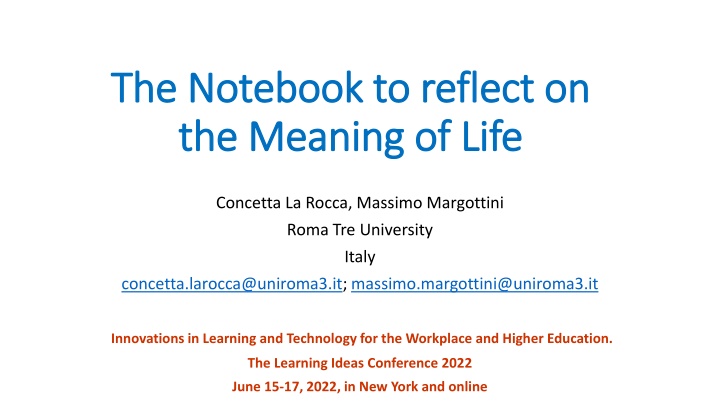

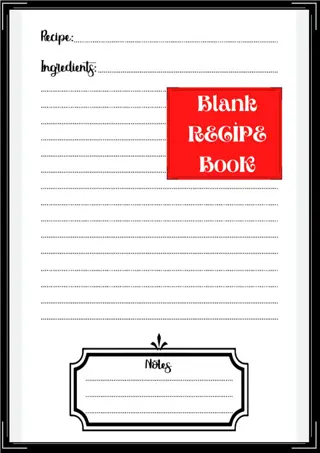

![GET [✔PDF✔] DOWNLOAD✔ My Vegan Recipe Notebook for all your recipes - 6x9 i](/thumb/68090/get-pdf-download-my-vegan-recipe-notebook-for-all-your-recipes-6x9-i.jpg)
